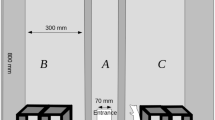Abstract
The behavior to foods in rats (Rattus norvegicus) was investigated in a seminatural enclosure and in a straight alley in the laboratory. In both situations, the size of food (0.045-, 1-, and 3-g pellets were used in the enclosure and 0.045-, 0.2-, 1-, and 3-g pellets in the alley) and distance between food sites and nest site (1.8, 3.6, 5.4, and 7.2 m in the enclosure and 2, 4, and 6 m in the alley) were varied. In both situations, when food was presented in only 1 place, the food carrying behavior increased as the size of food increased from 0.045 to 1-g. One and three g pellets were always carried, regardless of the distance to nest. On the other hand, when multiple food sites were presented in the alley, rats were more likely to carry small pellet from the further food site, whereas large pellet was always carried and were not influenced by the distance. The behavior to foods in the enclosure, however, was not influenced in either food site condition. This might be due to the difference in familiarity to the environment and anxiety from perceived predation risk.
Similar content being viewed by others
References
Andersson, M. 1978 Optimal foraging area: Size and allocation of searching effort.Theor. Popul. Biol., 13: 397–409.
Ash, M., & W. Roberts 1992 Central-place foraging by rats on the radial maze: The effects of patch size, food distribution, and travel time.Anim. Learn. & Behav., 20: 127–134.
Bindra, D. 1948 What makes rats hoard?J. Comp. Physiol. Psychol., 41: 379–402.
Calhoun, J.B. 1962 The ecology and sociobiology of the Norway rat. Public Health Service Publication. Washington, DC.
Fantino, M., & M. Cabanac 1980 Body weight regulation with a proportional hoarding response in the rat.Physiol. Behav., 24: 939–942.
Fantino, M., & M. Cabanac 1984 Effect of a cold ambient temperature on the rat's food hoarding behavior.Physiol. Behav., 32: 183–190.
Killeen, P., & M. Riggsford 1989 Foraging by rats: intuitions, models, data.Behav. Proc. 19: 95–105.
Lessels, C.M. & D.W. Stephens 1983 Central place foraging: Single prey loaders again.Anim. Behav., 31: 238–243.
Lima, S.L., T.J. Valone, & T. Caraco 1985 Foraging-efficiency-predation-risk trade-off in the grey squirrel.Anim. Behav., 33: 155–165.
Lima, S.L., & T.J. Valone 1986 Influence of predation risk on diet selection: a simple example in the grey squirrel.Anim. Behav, 34: 536–544.
McNamara, R.K., & I.Q. Whishaw 1990 Blockade of hoarding in rats diazepam: an analysis of the anxiety and object value hypotheses of hoarding.Psychopharmacol., 101: 214–221.
Miller, G.A. & P. Viek 1944 An analysis of the rat's response to unfamiliar aspects of the hoarding situation.J. Comp. Psychol., 37: 221–231.
Orians, G.H. & N.E. Pearson 1979 On the theory of central place foraging. In: D.J. Horn, G.R. Stairs, and R.D. Mitchell (eds.)Analysis of ecological systems, pp. 157–177. Columbus: Ohio State University Press.
Phelps, M., & W.A. Roberts 1989 Central place foraging byRattus norvegicus on radial maze.J. Comp. Psychol., 103: 326–338.
Schoener, T.W. 1979 Generality of the size-distance relation in models of optimal feeding.Am. Nat., 114: 902–914.
Smith, J.P., J.S. Maybee, & F.M. Maybee 1979 Effects of increasing distance to food and deprivation level on food hoarding inRattus norvegicus.Behav. Neur. Biol., 27: 302–318.
Stellar, E., & C.T. Morgan 1943 The roles of experience and deprivation in the onset of hoarding behaviour in the rat.J. Comp. Psychol., 36: 47–55.
Wallace, R.J. 1978 Hoarding of inedible objects by albino rats.Behav. Biol., 23: 409–414.
Wallace, R.J. 1983 Saccharin hoarding by albino rats: further evidence on incidence and object retrieval.J. Gener. Psychol., 108: 211–224.
Whishaw, I.Q. & J. Tomie 1989 Food-pellet size modifies the hoarding behavior of foraging rats.Psychobiol., 17: 93–101.
Whishaw I.Q. 1990 Time estimates contributes to food hoarding decisions by rats: Implications for neural control of hoarding.Psychobiol., 18: 460–466.
Wolfe, J.B. 1939 An exploratory study in foodstoring in rats.J. Comp. Psychol., 28: 97–101.
Author information
Authors and Affiliations
About this article
Cite this article
Nakatsuyama, E., Fujita, O. The influence of the food size, distance and food site on food carrying behavior in rats (Rattus norvegicus). J. Ethol. 13, 95–103 (1995). https://doi.org/10.1007/BF02352568
Received:
Accepted:
Issue Date:
DOI: https://doi.org/10.1007/BF02352568




